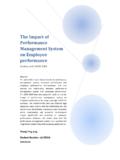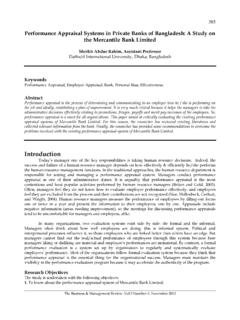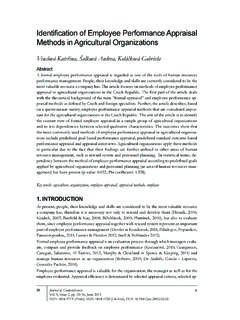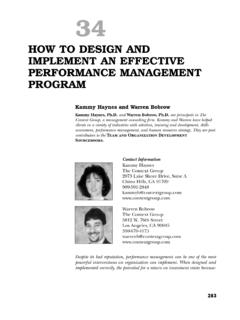Transcription of Performance Management: The Performance …
1 Performance management : The Performance appraisal Linda Olson, Child Support Supervisor (Dakota) Trish Skophammer, Child Support Assistant Director (Ramsey) Linda Bixby, Economic Support Division Manager (Washington) Performance management is the process that allows an organization to improve its effectiveness in the accomplishment of its mission and goals. Plan Develop Monitor Review Reward Performance management System Components: OPlan work and set standards ODevelop the capacity to perform, OMonitor Performance , OReview Performance in a prescribed process, and OReward quality Performance .
2 OCreate clear job descriptions OCommunicate the mission and goals OSet Performance standards OMeasure outcomes OInvolve staff in the process (what, why, how) OUse the standards and measurements in Performance appraisals OBuild in f lexibility; things change Plan OIncrease capacity through training OGive assignments to gain new skills and take on more responsibility OEncourage good Performance OStrengthen skill development OProvide opportunities to keep up with a changing workplace ( , technology) Develop OConsistently measure Performance OProvide regular feedback to employees and teams OTrack progress toward goals OProvide an opportunity to make changes to unrealistic standards OIdentify areas for development/training OIdentify unacceptable Performance prior to a formal review Monitor OMeasure actual Performance against expected Performance OProvide an opportunity for the employee and supervisor to exchange ideas and perspectives about job Performance OIdentify training and development needs.
3 And plan for career growth OSupport alignment of organizations and employee goals Review OProvide an instrument to compare Performance among all employees OProvide a process to look toward the future OProvide the basis for determining compensation adjustment based on merit OProvide legal protection against lawsuits for wrongful termination Review OAcknowledge individual contributions and team successes OCan be informal or formal OMake it the normal course of doing business OHas a big impact on: staff commitment how employees do their jobs job satisfaction workplace environment and image Reward The Performance Purpose of the appraisal OEvaluate Performance relative to the job classification ODetermine if we re meeting the needs of clients and stakeholders OImprove as an office and as individuals OPromote innovation and efficiency Purpose of the appraisal OImprove communication between management and employees OExplore different and new assignments OCommunicate strengths OIdentify areas in need of
4 Improvement and create plans for improvement Purpose of the appraisal OPromote growth and development OIdentify areas where training is needed ORecognize exceptional employees OPromote a culture of excellent and commitment to public service OIdentify how managers can help Components of a Review OAssessment of technical knowledge and abilities OQuality and quantity of work ODegree and success in meeting goals ODegree of success in defined work areas and traits OProfessional development OCommittee and workgroup involvement OSetting new goals General Tips OBe present Be available to observe your staff Observations validate your data OPromote a Performance culture Expect and support high Performance Communicate consistent messages about Performance General Tips ORelative Performance is important Provide the context Explain why it matters ODon t ignore Performance problems Learn how to address issues Practice Address issues timely Common Mistakes OInadequately defined, or misunderstanding of.
5 Performance standards OOver-emphasis on recent Performance OWaiting for the evaluation to give feedback OReliance on gut feelings OBeing overly positive or overly negative OLack of appraiser preparation Common Mistakes OHesitance to make subjective conclusions OViewing the appraisal as an isolated event rather than an ongoing process OInsufficient or unclear Performance documentation OInadequate time allotted for the discussion OToo much talking by the supervisor and/or not enough listening OLack of a follow-up plan Coffee Talk Scenario 1 Tips for New Supervisors ODon t radically alter prior rankings without objective data OReview the previous Performance evaluations OReview the previous supervisor s file OConsider expressing concerns verbally rather than in the Performance evaluation, and then document the discussion OIf you can t back it up, don t say it OCall peers in other counties for support, ideas and advice Documenting Critical Incidents and Significant Behaviors Record these as soon as possible, stick to the facts.
6 Critical Incident O Event that is usually extreme O Good or bad Significant Behaviors O Noteworthy conduct that impacts Performance O Positive or negative Documentation OIncreases the accuracy of the Performance appraisal OProvides evidence to support ratings OGuarantees that you will consider the Performance during the entire review period OReduces bias that occurs when you rate only recent behavior OSupports actions you need to take in the future appraisal Forms OPoorly constructed forms can prevent good discussion OAvoid rating inf lation Balance is important Glowing evaluations don t motivate; everyone will know it s a fraud OUnderstand the pitfalls of rating scales Tendency for employees to focus on how they were scored.
7 Often viewed as a report card or grade. appraisal Forms OThe emphasis should be on the narrative (detail) of your evaluation, not on the actual rating assigned. OSqueeze the rating scale. Example: Sue performs on the high end of benchmark for her technical knowledge. Moving Beyond Writer s Block ODevelop a system to track Performance and behavior throughout the year OUse the job description as a starting place OUse objective, measurement-oriented language: Don t overuse vague, generic terms such as good or excellent Focus on action words.
8 Exhibits, demonstrates, grasps, generates, manages, possesses, communicates, achieves Moving Beyond Writer s Block OStick to the facts OChoose words that focus on Performance , not personality OAdd examples to illustrate your analysis OComplete the review over time, revisiting periodically until done Moving Beyond Writer s Block Resources ONeal, Jr., James. Effective Phrases For Performance Appraisals. Ohio: Neal Publications, Inc, 2000. OMax, Douglas and Robert Bacal. Perfect Phrases for Performance Reviews. New York: The McGraw-Hill Companies, Inc.
9 , 2003. OFalcone, Paul. 2600 Phrases for Effective Performance Reviews. New York: AMACOM, a division of American management Association, 2005. Engaging Employees Employees may hesitate to engage in the Performance evaluation process when they: ODon t understand the purpose OAre afraid, or not given an opportunity, to express their opinion OAre not given time to prepare OTheir thoughts and ideas are discounted OThe process feels meaningless Engaging Employees Ideas: OSchedule regular informal check points to discuss work and goal progress ODiscuss actual Performance data/significant behaviors OCompare data with responsibilities/goals OFocus on finding solutions to problems, not on finding fault Engaging Employees OMaintain a positive focus OExpress confidence that there are solutions to problems OSolicit and use feedback from your employee relating to their Performance .
10 Goal development and action plans OProvide recognition Engaging Employees ODiscuss specific actions for you and the employee to take OCoach when opportunities arise OUse two-way communication (see Conversation Starter handout) OAdd a self-evaluation component to your review process Coffee Talk Scenario 2 Managing Employee Reactions OGive frequent feedback OAddress Performance pro












